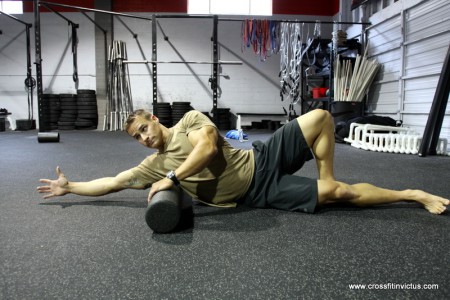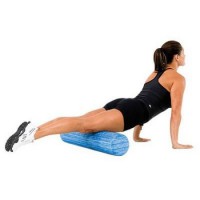Several years ago foam rolling was the “in” thing and everyone used and praised it. Self “mobility” work has since evolved away from foam rolling — even to the point of poopooing it — but it can still serve a purpose.
Most Tommy Tough Guys will say, “Ptsh, foam rolling is too light, I just use a a PEEH-VEH-CEE.” An actual foam roller won’t correct any real soft tissue problem, but that’s not its effective purpose. Foam rolling is best used prior to activity or training to loosen up the soft tissue (which can include fascia, muscles, or tendons) to be more pliable and allow a comprehensive range of motion (ROM). Think of it as a part of warming up instead of soft tissue treatment.
Trainees lament that a large portion of their day is spent sitting down. And if they’re standing up or doing manual labor, they’re still probably not going through a full ROM and spend time in problematic positions (bending over, crouched down, on knees, etc.). Either way, loosening up the body with a foam roller will prep those structures for activity, whether applying force maximally or ballistically. This light soft tissue work will augment any movement prep like dynamic stretching or any “mob” that includes positional stretching. Heavy, invasive massages prior to training can have a deleterious effect on performance, yet light massages can make the structures more pliable, increase blood flow to the area, and even reduce Delayed Onset Muscle Soreness (DOMS) quicker.
At worst you’re increasing your warm-up by five to ten minutes. At best you’re enhancing that warm-up, improving recovery, and prepping your structures to train better.
One reason that a PVC may not be as useful in the context of a warm-up is because it’s more invasive and painful. Tommy Tough Guy Mentality says, “I can take it. BRING ON THE PAIN.” Just because you can deal with pain doesn’t mean you’re a) cool or b) doing anything useful. In actuality it’s not easy to undergo pain and completely relax a muscle. The point is to get some light massage through the muscle belly tissue, not to tense up and contract the muscle because it’s experiencing pain and try to massage a taught muscle. By using foam, you can reach deep into the tissue without tensing up or disrupting the cellular environment too much.

When I googled “sexy foam rolling” to see what would come up, I found this picture of my jacked friend, Mark. Care to explain, Mark?
This isn’t to say that PVC is worthless, but it’s most likely inferior for warm-up purposes for most people. Note that over time your tissues will adapt to the foam roller and you’ll need a harder surface to receive the same effect. That means if you’ve been foam rolling daily for a couple of years, then no, this won’t apply to you. Foam rollers can cost 15 to $20 and PVC can cost a few dollars. I think they both serve a purpose, especially when you don’t have a servant to give you a rub down prior to training (yeah c’mon). In case you’ve haven’t gotten on the internet since 2005, here’s a video of a foam rolling protocol, specifically what I do before training. I aim to loosen tension on my back, hips, and knees. I could probably accomplish the same with a PVC, but I know it’d cause some “tensing up” in my thighs or around my knees. The PVC also crunches on the spinous processes of my vertebral segments when rolling certain positions on my back. If all you need is a light massage, and you have access to a foam roller, then it’s a better tool. If you’re interested in exploring different options, consider the benefits of therapeutic massage as well.

